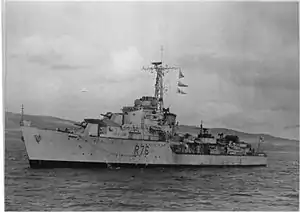HMS Consort (R76)
HMS Consort was one of thirty-two C-class destroyers built for the Royal Navy during the Second World War, a member of the eight-ship Co sub-class.
 Consort on the River Clyde in 1946 | |
| History | |
|---|---|
| Name | Consort |
| Ordered | 14 August 1942 |
| Builder | Alexander Stephen & Sons, Linthouse |
| Laid down | 26 May 1943 |
| Launched | 19 October 1944 |
| Commissioned | 19 March 1946 |
| Identification | Pennant number: R76 |
| Fate | Arrived for scrapping at Swansea on 15 March 1961 |
| General characteristics (as built) | |
| Class and type | C-class destroyer |
| Displacement | 1,865 long tons (1,895 t) (standard) |
| Length | 362 ft 9 in (110.6 m) o/a |
| Beam | 35 ft 8 in (10.9 m) |
| Draught | 15 ft 3 in (4.6 m) (full load) |
| Installed power |
|
| Propulsion | 2 shafts; 2 geared steam turbines |
| Speed | 36 knots (67 km/h; 41 mph) |
| Range | 4,675 nautical miles (8,658 km; 5,380 mi) at 20 knots (37 km/h; 23 mph) |
| Complement | 186 |
| Armament |
|
Design and description
The Co sub-class was a repeat of the preceding Ch sub-class. Consort displaced 1,865 long tons (1,895 t) at standard load and 2,515 long tons (2,555 t) at deep load. They had an overall length of 362 feet 9 inches (110.6 m), a beam of 35 feet 8 inches (10.9 m) and a deep draught of 15 feet 3 inches (4.6 m).[1]
The ships were powered by a pair of geared steam turbines, each driving one propeller shaft using steam provided by two Admiralty three-drum boilers. The turbines developed a total of 40,000 indicated horsepower (30,000 kW) and gave a speed of 36 knots (67 km/h; 41 mph) at normal load.[2] During her sea trials, Consort reached a speed of 31.6 knots (58.5 km/h; 36.4 mph) at a load of 2,356 long tons (2,394 t).[3] The Co sub-class carried enough fuel oil to give them a range of 4,675 nautical miles (8,658 km; 5,380 mi) at 20 knots (37 km/h; 23 mph). The ships' complement was 186 officers and ratings.[1]
The main armament of the destroyers consisted of four QF 4.5-inch (114 mm) Mk IV dual-purpose guns, one superfiring pair each fore and aft of the superstructure protected by partial gun shields. Their anti-aircraft suite consisted of one twin-gun stabilised Mk IV "Hazemeyer" mount for 40-millimetre (1.6 in) Bofors guns and two single 2-pounder (40 mm) AA guns amidships, and single mounts for a 20-millimetre (0.8 in) Oerlikon AA gun on the bridge wings.[1] The ships were fitted with one quadruple mount for 21-inch (533 mm) torpedo tubes.[4] The ships were equipped with a pair of depth charge rails and two throwers for 35 depth charges.[5]
Construction and career
Consort was ordered from Alexander Stephens & Sons and the ship was laid down on 26 May 1943 at its shipyard in Linthouse, launched on 19 October 1944 and was commissioned on 19 March 1946.[1]
Consort was damaged by artillery fire during the Yangtze Incident in an attempt to tow the sloop Amethyst from a mudbank, taking 56 direct hits, and causing casualties of 23 wounded and a further ten dead.[6]
Following decommissioning she was sold to the Prince of Wales Drydock Co., of Swansea, Wales, for scrap and arrived there on 15 March 1961.[7]
References
- Lenton, p. 183
- Whitley, p. 136
- March, p. 429
- Chesneau, p. 43
- March, p. 424
- Cotterell, Arthur (26 January 2010). Western power in Asia: its slow rise and swift fall, 1415-1999. John Wiley & Sons. p. 307. ISBN 978-0-470-82489-4.
- English, p. 139
Bibliography
- Chesneau, Roger, ed. (1980). Conway's All the World's Fighting Ships 1922–1946. Greenwich, UK: Conway Maritime Press. ISBN 0-85177-146-7.
- Colledge, J. J.; Warlow, Ben (2006) [1969]. Ships of the Royal Navy: The Complete Record of all Fighting Ships of the Royal Navy (Rev. ed.). London: Chatham Publishing. ISBN 978-1-86176-281-8.
- English, John (2001). Obdurate to Daring: British Fleet Destroyers 1941–45. Windsor, UK: World Ship Society. ISBN 978-0-9560769-0-8.
- Friedman, Norman (2006). British Destroyers and Frigates, the Second World War and After. Annapolis, Maryland: Naval Institute Press. ISBN 1-86176-137-6.
- Lenton, H. T. (1998). British & Empire Warships of the Second World War. Annapolis, Maryland: Naval Institute Press. ISBN 1-55750-048-7.
- March, Edgar J. (1966). British Destroyers: A History of Development, 1892–1953; Drawn by Admiralty Permission From Official Records & Returns, Ships' Covers & Building Plans. London: Seeley Service. OCLC 164893555.
- Marriott, Leo (1989). Royal Navy Destroyers Since 1945. Ian Allan. ISBN 0-7110-1817-0.
- Whitley, M. J. (1988). Destroyers of World War Two: An International Encyclopedia. Annapolis, Maryland: Naval Institute Press. ISBN 0-87021-326-1.